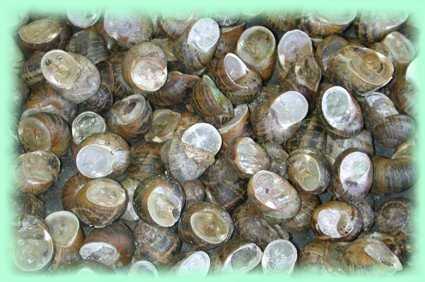
Reproduction takes place in early summer, and begins with pairing and courtship. They hibernate through the winter in similar locations (5). Garden snails are hermaphrodites, meaning that one individual possesses both male and female reproductive organs although they are able to self-fertilise, most snails mate with another snail (4). This snail has a strong homing instinct, and spends the day, often in large groups, beneath stones and other structures. They feed on a range of plant matter, and can be serious pests of gardens (4).

It moves by means of a muscular foot the mucus secreted by the foot aids with movement and leaves a tell-tale track behind. This snail is mainly nocturnal but will emerge after rain during the day. The mouth is located beneath the tentacles, and contains a chitinous radula with which the snail scrapes and manipulates food particles. The snail extends the tentacles by internal pressure of body fluids, and retracts all four tentacles into the head by invagination when threatened or otherwise retreating into its shell.

The head bears four tentacles the upper two are larger and bear eye-like light sensors, and the lower two are tactile and olfactory sense organs. These mechanisms allow Cornu aspersum to avoid either fatal desiccation or hydration during months of either kind of quiescence.ĭuring times of activity the snail's head and "foot" or "belly" emerge. The snail also has an osmoregulatory mechanism that prevents excessive absorption of water during hibernation. During aestivation, the mantle collar has the ability to change its permeability to water. When hibernating, Cornu aspersum avoids the formation of ice in its tissues by altering the osmotic components of its blood (or haemolymph) this permits it to survive temperatures as low as -5☌ (23☏). The snail's quiescent periods during heat and drought are known as aestivation its quiescence during winter is known as hibernation. The epiphragm helps the snail retain moisture and protects it from small predators such as some ants. It has no operculum during dry or cold weather it seals the aperture of the shell with a thin membrane of dried mucus the term for such a membrane is epiphragm. When injured or badly irritated the animal produces a defensive froth of mucus that might repel some enemies or overwhelm aggressive small ants or the like. The body is soft and slimy, brownish-grey, and the animal retracts itself entirely into the shell when inactive or threatened. The shell is variable in color and shade but generally is dark brown, brownish golden, or chestnut with yellow stripes, flecks, or streaks (characteristically interrupted brown colour bands).The aperture is large and characteristically oblique, its margin in adults is white and reflected. The adult bears a hard, thin calcareous shell 25–40 mm in diameter and 25–35 mm high, with four or five whorls. In English texts it was classified under the name Helix aspersa for over two centuries, but the prevailing classification now places it in the genus Cornu. Of all terrestrial molluscs, this species may well be the most widely known.

As such it is a terrestrial pulmonate gastropod mollusc in the family Helicidae, which include the most commonly familiar land snails. Cornu aspersum, known by the common name garden snail, is a species of land snail.


 0 kommentar(er)
0 kommentar(er)
